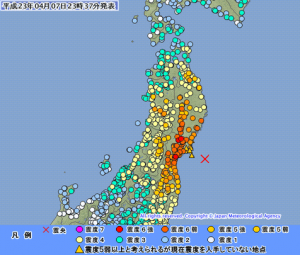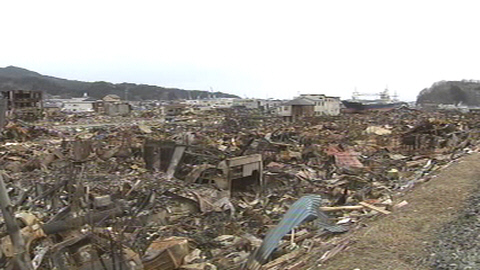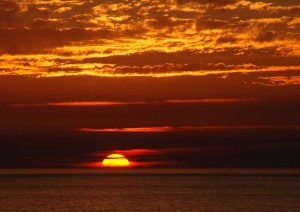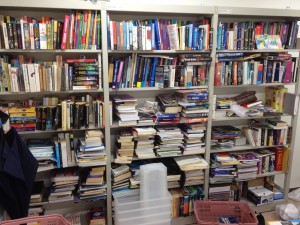Remembering the earthquake
Yesterday marked one year since the Great East Japan Earthquake.
Living here in Sendai it was quite a big deal for us, although my family and I were extremely fortunate not to lose any close friends or family members. Many were not so fortunate.
There are still reminders of the damage all around us. Walking to work this morning, I passed a boarded up business: the building unrepaired and the signs taken down. Flying into Sendai airport yesterday, the full extent of the devastation is clear: the coastline a tabula rasa, devoid of buildings or people. On the drive home the expressway cuts through flooded rice fields: it will be years before the sea salt is leeched out and they can be used again.
Experiencing a major disaster is different for everyone. Normally it is something personal: the death of a loved one, the loss of a job, a crippling accident. This time we all experienced it together, and yet each person reacted in their own way. There is almost an illusion of commonality, but deep down everyone’s reality is different.
I’m not sure how I feel about the news on TV, the postings on Facebook, and the emails sent to lists. In a way I’m glad that people haven’t forgotten, that Tohoku remains in people’s thoughts. On the other hand I feel this is quite a private topic for me. In the aftermath of the earthquake last year I did talk about it (you can see my blog posts Part One, Part Two, and Part Three on our experience immediately after 3.11). However, since then I have felt the need to talk about it less and less. I still find myself getting emotional watching documentaries about the ‘triple disaster’, and it will be years before we find out if radiation fears were warranted or not. The Great East Japan Earthquake Disaster is ongoing in many ways. It is both mundane, in that it is part of every day life here, and extraordinary, in that it was (hopefully) a once-in-a-lifetime event. The media will probably stay on the story for now, and people are going to keep talking about it online.
But I’m not sure I want to. In a way, I feel it belongs more to those whose lives were irrevocably changed. I was frightened, it was tough, we had to move, it was very stressful, but we got through it. For others though, who lost people close to them, whose towns were literally wiped off the map, who are still living in temporary accommodation, it’s not just another war story.
I thought this article from the New York Times was beautiful.
*the image at the top of this post is the data for the second earthquake, the one that did more damage to buildings in Sendai but much less overall as it did not trigger a tsunami. One of the thousands of strong aftershocks in the region.
The Great East Japan Disaster Part One: Earthquake
Okay, so I am going to hijack my own blog to shamelessly share some thoughts and experiences from the last few weeks. This is partly in order to give myself an outlet, as well as to provide an easily accessible record I can refer friends and family to. Don’t worry, we’ll be going back to educational topics soon enough.
Part One: Earthquake
When the earthquake happened I was in one of the Cambridge English classrooms. I was supposed to be observing a kids’ class from 15:40, as one of our teachers was leaving, and we were just setting up and cleaning the classroom.
At 14:46 the earthquake started. For a week or so beforehand, we’d had a series of smaller earthquakes, so we weren’t particularly worried. I moved to the back door and opened it and the other teacher did the same at the front. However, the shaking continued much longer than usual, and got stronger and stronger. It got to the point where we had to force ourselves not to run outside (leaving the building during an earthquake is usually more dangerous as you are more likely to be injured by falling objects or broken glass than by a building collapse).
The earthquake had gone on for several minutes, when suddenly there was a sharp sideways motion, and everything in the room that wasn’t fixed down (and a few things that were, like shelves that were screwed into the wall) flew sideways. Computers, printer, plant pots, and hundreds of books were launched into the air and ended up in big piles on the floor.
Thankfully, it stopped shortly after that.
Walking outside, we went to check on friends who run a restaurant nearby. They were fine, but the restaurant was a real mess, with broken glasses and bottles everywhere. We decided to wait outside in a nearby park, away from power lines and buildings, just in case.
It was a very cold day, not the kind of weather you want to be standing outside in the cold for. We did that for an hour or so and experienced several aftershocks. Then it started snowing, so we set off for home by car. The roads were jammed, and damaged in places. Some sections were cracked, or bulged up, or had collapsed. I tried to call or email my family, but everything was down (after an earthquake, everyone tries to call at once and the system gets overloaded). Fortunately, Facebook was working so managed to get in touch with family and friends that way.
Social networks really came into their own during the disaster, allowing people to keep in touch and organise themselves.
Anyway, after two hours in stop-start traffic, we got home. The power was out throughout the city, so none of the traffic lights worked. Surprisingly, there were no accidents and everyone became really considerate drivers. Once it got dark the streets became dangerous, as the streetlights were also out. Pedestrians and cyclists were almost impossible to see. Lines of people formed at public phones, as they seemed to still be working.
At home we broke out some candles and tried to keep warm. Our house is quite old, so we have several kerosene heaters. Most of them require electricity, but luckily two of them are the old stove type so we managed to get them going.
It was pretty eerie: the blacked out silent city where the only noises were the sirens of emergency vehicles in the distance. It was the first time I saw the stars in Sendai.
That evening we went to our local refuge (each neighborhood in Japan has a designated place people should go to in a disaster -usually a school) but they didn’t have any food or water yet. We also went to check on another of our teachers, as well as family members. What should have been an hour’s drive took seven hours, and we got back home at 3am.
At one point we had to drive through water (in Nakano Sakae near Tagajo) but we had no idea of the significance. With no power we were not getting much news so we had no idea of the true scale of the tragedy on the coast. Despite the blackouts, we didn’t think too much of the earthquake as there was not much damage to buildings: they held up incredibly well.
The next day we again drove out to check on our classrooms and one of the girls’ apartment, taking food and drink and leaving everything else. We managed to find an open shop where we bought vegetables and were feeling quite positive by the time we got home. Cooking on the kerosene heaters was slow but worked, and we had a simple dinner of fish and vegetables, which was great after 24 hours of eating chocolate and snacks.
Full, warm, and safe, we faced our second night after the earthquake in good spirits (remember, we still had no real news about the scale of things).
Extensive Reading World Congress next week in Seoul, Korea
I am really excited about attending (and presenting at) the ERWC next week in Seoul. I was forced to cancel my plans for the first one due to fallout from the earthquake, so this is going to be my first time at the global extensive reading event.
Details are here, the schedule is here, and I am hoping to see you there 🙂
blogging earthquake expectations life in Japan living in Japan personal refugee
by sendaiben
leave a comment
Shock Therapy: how a geological event helped cement my minimalist leanings
This post was originally written for an ebook project that never happened. I’m happy to publish it here now.
Are you a wannabe minimalist? I was. It took a major natural disaster to change that.
I became interested in a minimalist lifestyle a couple of years ago. It started with Leo Babauta and Zen Habits, and progressed to Karol, Tynan, Baker, and others. It was appealing, and I spent hours reading articles, following blogs, looking at lists of possessions and checking out minimalist workspaces.
I didn’t actually do anything to change my life, but it was fun thinking about it.
I guess I had the desire but not the drive, the talk but not the walk. I suspect this may be very common, with a small core of people actually living a minimalist lifestyle, and a wider circle of spectators seeing the benefit but not taking action.
This all changed in March 2011. I was just getting ready to teach on an ordinary Friday afternoon when the fourth largest earthquake in recorded history hit the city I live in, doing substantial damage in itself and causing a devastating tsunami. Luckily my seven year-old students hadn’t arrived at the classroom yet, so I didn’t have to worry about them being hurt when everything in the room flew five feet sideways, including computers, tables, and bookshelves.
The earthquake lasted for about five minutes, which is about four and a half minutes too long for comfort. We’re used to earthquakes here, but they normally only last a few seconds. This one started, then got stronger and stronger, and everything just kept violently shaking for what seemed like forever.
After it finally stopped, I left the classroom and checked on some of our neighbors, then stood in a nearby park with other members of the community, all of us shocked into silence.
That evening I sat with my family in our large rental house by candlelight, surrounded by electrical appliances that no longer worked, huddling together for warmth under all our blankets and quilts.
The next day we foraged for food. Going through my daughter’s apartment, taking only food and water and leaving CDs, magazines, clothes, TVs, and furniture behind really made an impression on me. Likewise when we found all the shops closed and shuttered. Gas stations, chained up. Didn’t matter how good your credit was, how much money you had in your wallet.
We’re all just a couple of hours away from that.
That night, back at home taking stock, we received a couple of phone calls from friends and family abroad (I have no idea how they got through as the phone network was down) warning us about the unfolding nuclear accident in Fukushima. We live just under 100km away.
I made a quick decision based on a decision matrix taking into account what would happen under each of four scenarios: there were two variables, whether the accident was serious or not, and whether we left or not. The outcomes were, in turn:
1. the accident was not serious, and we stayed put: nothing happens
2. the accident was not serious, and we ran away: somewhat embarrassing and would cost some money
3. the accident was serious, and we stayed put: irradiation and mass panic when people realised what was happening
4. the accident was serious, and we ran away: safety and some monetary expense
There wasn’t much contest. I persuaded my family, we packed our cars, and we set off a couple of hours later, driving through the night and most of the next day until we got to relative safety in western Japan, several hundred kilometers and a mountain range away from the danger zone.
I locked our house and walked away from everything I owned that didn’t fit into a small bag. We got into the car and left forever as far as we knew.
And you know what? I didn’t care about any of it. For the four weeks we spent with relatives in Kanazawa, on the western coast of Japan, not once did I think of an actual thing we had left behind. Family? We took everyone with us. Friends? Yes. Students? Yes. Our stuff? Not once.
Not one piece of clothing, not one gadget, not one room of the (too) large house we rented.
And that’s when I became a real minimalist.
Just over two years after the event that changed everything, we are living in a small apartment (our rental house was structurally damaged and had to be knocked down), I haven’t bought anything physical for months (sadly, ebooks and music still draw my eye occasionally -I am not yet a digital minimalist), and I am consciously reducing the things I have left.
The next time we have to leave in the middle of the night, I’m hoping to be able to take everything with me.
Spring (summer) cleaning
After the storm of grading comes the calm of sorting papers, clearing up the office, and throwing things away.
This year I have more than usual as I am continuing my journey towards minimalism. I have hundreds of novels in my office that I am slowly disposing of, re-reading where necessary. It’s slow but enjoyable.
After last year’s earthquake, I had to move my office twice: once to temporary quarters, then to the prefabricated building we’re in now. Our actual offices are being fixed up and reinforced, and we should be able to move back by sometime next year (I say sometime because the actual date they’re supposed to be finished has already been moved back severa times).
My goal is to have very few things to move back, so that my office ends up being a peaceful and tidy place where I can work.
As you can see from the picture above, I have a long way to go.




